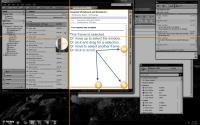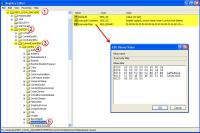SnagIt Beats SnagIt and It's Not Even Close
Memo to self: Stop saying, with each new edition of SnagIt, that the application cannot be improved. You will be wrong again. Most of the screen images you see on TechByter Worldwide are from SnagIt and there's a good reason: I haven't found anything better. SnagIt is now in double digits (version 10) and it's better than ever. In fact, after working with a review copy for less than 5 minutes, I ordered the latest version for the office. Yes, it's that good.
The most significant change, as far as I'm concerned, in version 10 is the "all-in-one" capture option. For years I've used 3 primary capture definitions—defined area, window, and full screen. The problem with that method is that I sometimes forget which definition I'm using and after I launch SnagIt, I realize that the wrong definition is active. I want a defined area, but the window capture is active. Version 10 eliminates that problem.
The solution is elegant.
 Hover the mouse at the top of the screen and you'll get a full-screen capture.
Hover the mouse at the top of the screen and you'll get a full-screen capture.- Hover the mouse over any window and you'll get a window capture.
- Click-and-drag a rectangle and you'll get a defined-area capture.
This is so astonishingly easy to comprehend that I'm surprised that I didn't think of it and recommend it to TechSmith years ago. It's funny how great ideas seem so obvious in retrospect, isn't it?
This one feature alone is worth the $25 upgrade fee. But there's more.
Transparency: If you save the final image to a format that supports transparency (PNG, GIF), your screen captures can float on your Web page or Powerpoint program.
Improved Text: SnagIt now allows you to rotate text boxes if you need something other than standard horizontal text.
Uploads to Screencast.com: This is a free service provided by TechSmith that allows users to store screen captures for review by co-workers. Instead of sending the images by e-mail, just upload them to Screencast. Uploads can be public, private, or password-protected and those who view the files can comment on them. When that happens, you can receive an e-mail notification.
Auto-scroll finally works: For several versions, the auto-scroll function didn't always work as intended. Now it's easier to select (from the all-in-one interface) and it's more reliable.
Perfection is Elusive
For all of the great new features and despite my praise, I wish that TechSmith had spent a little more time testing this version before releasing it. I have found and reported several bugs to the company and TechSmith has been able to replicate most of them. Fixes are promised for a future maintenance release.
 Files can be renamed improperly by the Multi-Rename function: Sometimes not all selected files are renamed; other times, non-selected files are renamed; numbers are sometimes skipped. TechSmith determined that there is a bug in the rename code.
Files can be renamed improperly by the Multi-Rename function: Sometimes not all selected files are renamed; other times, non-selected files are renamed; numbers are sometimes skipped. TechSmith determined that there is a bug in the rename code.
 When multiple renames happen and the view is sorted by title, the list is re-ordered during the rename process. This confuses the sorting.
Workaround: Sort the files by something other than name before renaming them.
When multiple renames happen and the view is sorted by title, the list is re-ordered during the rename process. This confuses the sorting.
Workaround: Sort the files by something other than name before renaming them.- Keyboard copy/paste functions are not available when renaming files: This isn't a new bug and I've complained about it previously. To copy or paste when you're manually renaming a file, it's necessary to right-click the selected text and use the context menu. SnagIt has not responded to this complaint. When the multi-rename function works properly, it's not particularly important.
- The Finish button doesn't finish: In previous versions, selecting Finish performed SnagIt's final action with the screen capture. In many cases, that final step is to write a file to the disk. Then the Finish button became inactive. Now it remains active, which leads the user to think that the file hasn't yet been written. Pressing the button again creates a second copy of the file.
- The editor view pop-up image doesn't change after a file is deleted: When the mouse cursor hovers over an image in the Open Captures Tray, a larger view pops up. If you delete the top left image from the Open Captures Tray by clicking the X that is displayed on the image, the capture is dropped but the larger image of the now-deleted image remains. TechSmith has confirmed this bug and will fix it in a future release.
- Sometimes an imaged that should be copied to the Clipboard never reaches the Clipboard (may be a Windows 64-bit problem): TechSmith is having a difficult time replicating this problem and additional research suggests that it is at least partially a Windows bug with 64-bit versions of Vista and Windows 7. In many cases, repeatedly copying from SnagIt to the Clipboard eventually places the image on the Clipboard. Sometimes no amount of copying transfers the image to the Clipboard.
I don't consider any of these bugs to be a true show-stopper. The most annoying problem is the one that involves the Clipboard and that one may not be something that TechSmith can resolve. The most dangerous bug is the multi-rename bug because incorrect file names could wreak havoc on several hours worth of work. The workaround is easy enough, but the bug needs to be fixed soon.
 Bottom Line: SnagIt Defines the New Standard for Screen Captures
Bottom Line: SnagIt Defines the New Standard for Screen Captures
I'm not going to say they can't do it any better because I know that version 11 will include improvements that I can't live without. But if you need to grab what's on your screen to share with others and you want the best screen capture application on the market, you need SnagIt.
For more information, visit the TechSmith website.
Fixing a Keyboard
In an earlier episode, I mentioned that Microsoft replaced a keyboard when I complained about the markings wearing away on some of the more-used keys. At the time, I complained that the replacement, like the keyboard it replaced, had several keys in what I consider to be the wrong places. I was forever pressing Insert when I wanted Home or Delete when I wanted End. When I'd finally had enough, I pried some keys off the keyboard and moved them. Then I edited the Registry. The keys are now where I want them.
The process is surprisingly easy. Physically moving the keys was easy enough because they are all the same size and shape. All that's required is a small screwdriver for leverage and a bit of careful prying to remove the keys. Next, I placed the keys that I wanted to move in their new locations and pressed down to lock them into place.
At this point, the keyboard would have a bit confusing because:
- Pressing Home switched the typing mode between insert and overstrike.
- Pressing the Insert key moved the cursor to the beginning of the current line.
- Pressing the End key deleted the letter to the right of the cursor.
- Pressing the Delete key moved the cursor to the end of the current line.
So the next step involved editing the Registry to match up the keys with the scan codes that the keyboard sends when a key is pressed.
Simple. Start the Registry Editor, navigate to Local Machine - System - CurrentControlSet - Control - Keyboard Layout, create a new binary value called Scancode Map, enter 00000000000000000600000000003A0047E052E052E047E053E04FE04FE053E000000000, and restart the computer.
I did and it is. That long string of letters and numbers consists of some scan codes. You can read all about scan codes on a page at the Technical University in Eindhoven, Netherlands. (Don't worry; it's in English.)
Here's what the numbers mean:
- Header version: 0000 0000
This represents 4 bytes of data. All 4 bytes are 00. I show a space here for clarity, but you won't type a space and, if you do, the Registry Editor will ignore it. - Header flags: 0000 0000
The next 4 bytes are header flags. They are also always 00. - Number of key maps (+1): 0600 0000
This represents the number of keys that you will modify. In my case, I was planning to modify 5 keys, so I entered 6. The extra number represents the null terminator at the end of the string. More about that in a bit.
For 6, you might expect me to enter 0000 0006, but that would be entirely too logical. Numbers here are in what's called little-endian format, which means that they are in exactly the reverse order you might expect. This is also known as bass ackwards. Instead of writing 0000 0006, you write 0600 0000. You'll see this several more times. - Map Caps Lock key (003A) to null (0000): 0000 3A00
This specified the key to be mapped (Caps Lock, scan code 3A) and what it should be mapped to (null, 0000). I don't ever use the Caps Lock key, so I want to disable it.
This turns out to be doubly backwards because the numbers are written in little-endian format and they're also written so that the key you're mapping to is listed first and the key you're mapping from is listed second. So 0000 3A00 - Map Insert key (E052) to Home (E047): 47E0 52E0
This sequence places the Insert key function on the physical Home key. - Map Home key (E047) to Insert (E052): 52E0 47E0
This sequence places the Home key function on the physical Insert key. - Map End key (E04F) to Delete (E053): 53E0 4FE0
This sequence places the End key function on the physical Delete key. - Map Delete key (E053) to End: 4FE0 53E0
This sequence places the Delete key function on the physical End key. - Terminator: 0000 0000
This is the null terminator that indicates the end of the string.
The keyboard now works the way I want it to, or at least it works the way I think I want it to work. My fingers were starting to get used to the key positions and now they have to learn a new arrangement.
So that I could create the same arrangement on a similar keyboard at the office, I exported the Registry key and sent it to myself at the office.
Short Circuits
The FCC Finally Wants to Reclassify Broadband Providers
For some reason, this has taken on a political context and it's being framed as a "government takeover" of the Internet. The broadband providers are doing a superb job of spinning their story. Who created the Internet? Right, it was the government. Now the broadband providers want to take over control of the Internet so that they can control what you see. The FCC wants to regulate the Internet to keep it open the way it is now. And the broadband providers try to convince us that it's the government that wants to take over something. Up is down, open is closed, free is imprisoned, and we have always been at war with Oceania. [1984, Orwell]
This week, the FCC voted 3-2 to begin the process of responding to a federal court ruling in favor of broadband providers, a decision that would effectively end "Net neutrality", the doctrine that forces providers to treat all Internet traffic equally, regardless of where it comes from.
Eliminating Net neutrality would allow providers to deliver some data more slowly or to charge extra for it, or both. If you want choice, you want Net neutrality. It's as simple as that and it has nothing to do with politics.
Some years ago, the FCC incorrectly classified Internet service providers as information services instead of telecommunications services. Some of the big broadband operations have claimed that the FCC wants to control the content of the Internet. This is simply a lie and there's no nicer or politer way to put it.
The FCC is now soliciting public input on three possible options. The FCC could simply maintain the current regulatory policies, classify broadband as a telecommunications service and regulate it, or adopt a third option that is favored by the chairman and a majority of the commissioners.
The third option is a kind of compromise, a middle way. My preference would still be for full regulation, but that's unlikely. To let the FCC know how you feel about Net neutrality, visit the commission's website.
Want a New Iphone? You're not Alone
Apple says that more than half a million Iphones were ordered in the first 24 hours that they were on sale this week. The only reason the number wasn't higher was that technical problems stifled some of the orders. AT&T stores, for example, couldn't take orders.
The Apple statement characterized the event as being the largest number of pre-orders Apple has ever received in a single day. Phones ordered earlier this week will be delivered on the day the phones go on sale in retail stores next week. Apple is still accepting pre-orders, but you might have to wait until mid July to receive your phone.
The new model Iphone 4 is faster and thinner than its predecessor. The built-in camera is a 5-Mpxl device that can also shoot (and even allow some editing of) high-definition video.
Department of Justice Sues Oracle
Saying that Oracle engaged in price gouging, the US Department of Justice filed suit against Oracle. The suit claims that the company failed to disclose discounts and, as a result, overcharged the federal government by tens of millions of dollars. The General Services Agency's contracts are being reviewed and this is the third suit by the Justice Department in the past quarter.
Previously the DOJ filed suit against EMC for $87 million and the company settled out of court. The Justice Department said that EMC made false representations that resulted in the government paying higher prices than it should have.
In April, it was NetApp that settled a $128 million suit.
All 3 cases came to light as the result of inside information provided to the Justice Department by whistleblowers



 The author's image: It's that photo over at the right. This explains why TechByter Worldwide was never on television, doesn't it?
The author's image: It's that photo over at the right. This explains why TechByter Worldwide was never on television, doesn't it?
